Jewish History in Fort Collins: A Virtual Tour#
This is the virtual companion for the City's Jewish History walking tour. Before starting the tour, we encourage you to get to know more about local Jewish History and community in Fort Collins on our main page for this content, HERE.
If you live near downtown, we encourage you to access this tour by foot or by bike (there is on-street bike parking throughout this part of downtown). If not, this tour area can be accessed by transit (check HERE to find Transfort routes and schedules). If driving, we encourage you to park in the Firehouse Alley parking structure off Chestnut Street and walk/roll from there.
Please share the street and be respectful to the privacy of the owners and residents of the homes on this tour by viewing them from the street/sidewalk only.
Disclaimer: The information about sites below relies on primary source material from Fort Collins history that sometimes used racist and offensive terms to refer to Jewish Americans. In some cases, those terms have been included here to acknowledge and accurately reflect on the experiences of Jewish Americans in Fort Collins and the challenges they faced, and sometimes still face, while living here.
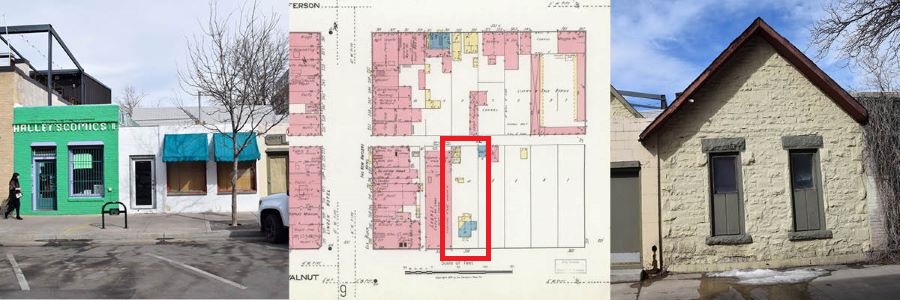
Photos: Left and Right: The Reingold shop and residence; Center: A 1917 Sanborn map showing the property prior to Reingold's conversion of it to a store.
1 - Reingold House & Junk Store, 322-26 Walnut Street#
This small stone house that’s now covered with some mid-twentieth century brick storefronts was first built some time before 1880 and is one of the earliest residential buildings in Fort Collins. Although it cycled through several uses and occupants in the late-1800s, in 1919, Charles Reingold and his family moved in. Charles and his family were Jewish, originally from Russia near Minsk, immigrating to Chicago in 1904. Charles, his wife Minnie (Gerber), also Russian, along with their children, arrived in Fort Collins by about 1915 or 1916, and in 1919, moved into the stone house. Almost immediately, Charles added the brick addition to the northwest corner of the house out of which he began running a junk store (similar to a thrift store today) out of this address. He used the stone warehouse off the alley to store extra inventory. Charles ran the store from 1919 until about 1956.
In addition to running the store, the Reingold family became central to the Jewish community of early Fort Collins. Because the Jewish community outside of Denver was so small, most Jewish religious observances and worship took place in private homes. A local congregation of B’nai Zion was established in Fort Collins in the 1920s – members purchased and kept a Torah as they held services in public meeting halls around town, but the congregation folded quickly. The Reingolds took on caretaking the Torah for the local community, holding services in the home here on Walnut Street. In 1956, Charles and Minnie transferred the property to their children. Minnie died in 1958, and Charles in 1963. The property has remained the location of small businesses in Fort Collins ever since.
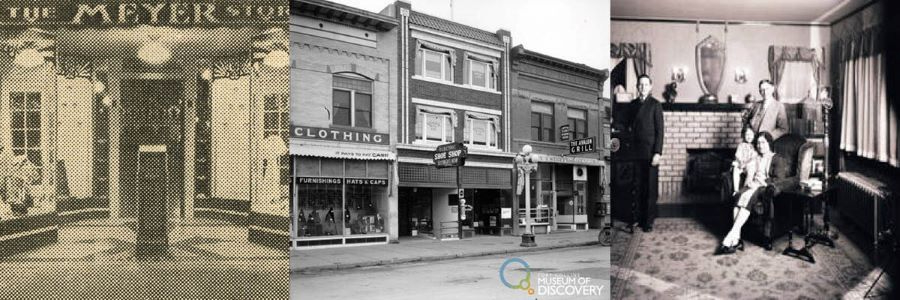
From left to right: The Meyer Store in 1936; The Meyer store in 1925; The Meyer family in 1927 (all Courtesy of the Fort Collins Museum of Discovery).
2 - Meyer Store, 130-136 S. College Ave#
Built in 1909, the Secord Block is one of several of the more substantial commercial buildings in downtown Fort Collins. In 1911, Samuel Meyer moved his shop from Linden Street to the ground floor of this building where it remained under his direction until 1942. Meyer was Jewish, born in Poland in 1877 and immigrated to the United States in the 1890s. He first settled in southeast Colorado, joining several of his brothers and moving to northeast Colorado where they established a regional collection of stores between Fort Collins, Loveland, Windsor, Greeley, and Sterling.
Samuel and Charles Meyer originally started their store at 222 Linden Street in 1905 but moved across the street in 1908 to a larger space – that same year Samuel married Ida Solomon of Chicago. Charles Meyer eventually went into traveling sales, still based in Fort Collins but leaving Samuel to operate the Fort Collins store. Once the Secord Block was finished, Samuel moved his store there where he remained the owner and manager into the 1940s, eventually renaming the building the Meyer Building. After Samuel sold the store in 1942, he went into real estate and insurance. He and Ida moved to Denver in 1953 – Samuel died there in 1961 and is buried in Fairmount Cemetery. Ida passed away the following year and is buried next to Sam.
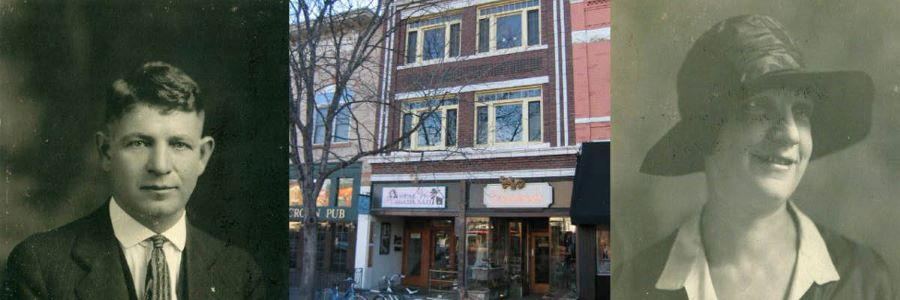
Images: Left and right, Joseph and Fannie Alpert, (Fort Collins Museum of Discovery); Center - Alpert Building, 140-142 S. College Ave.
3 - Alpert Building, 140-142 S. College Ave.#
The building here began as a one-story masonry building in 1903, at different times including a bicycle shop, a wallpaper and paint store, a photography studio, the offices of smaller local newspapers, an art store, a music store, and a shoe shop. In 1924, Joseph Alpert acquired the property and expanded it into the three-story building you see today. Alpert engaged famed local architect Montezuma Fuller to design the new building, which was completed in January of 1925. Once completed, Alpert rented the available spaces to a series of retail and office tenants, including barber shops and beauty salons, restaurants, the Electric Shoe Shop, and Alpert’s own real estate offices.
Joseph Alpert was born in 1877 into a Jewish family in Odessa in the Russian Empire (now Ukraine). Joseph was familiar with antisemitism from a young age, witnessing the murder of his grandparents during an anti-Jewish pogrom in about 1885. Pogroms were common in Russia through the 1800s and 1900s, with a particularly brutal series of violence in the Russian Empire from 1881-1884, concentrated in Kyiv, Odessa, and Warsaw (now in Ukraine and Poland, respectively). The Alperts left Russia and immigrated to the United States sometime in the late-1800s, settling in Cincinnati, Ohio. He learned shoemaking, and married a woman named Fannie Benjamin. They moved to Fort Collins in 1903 and Joseph opened a shoe repair shop at 220 Linden Street. Joseph moved his shoe shop to the one-story 140 S. College property in 1917, where he remained until he was able to buy and expand the building a decade later. Joseph was also active in the Municipal League and helped plan and build the new light and power plant at the north end of town along the Poudre River. Although he suffered a health emergency in the 1930s that led to the amputation of both of his legs, Alpert remained a prominent figure in Fort Collins business and real estate until his death in 1946.
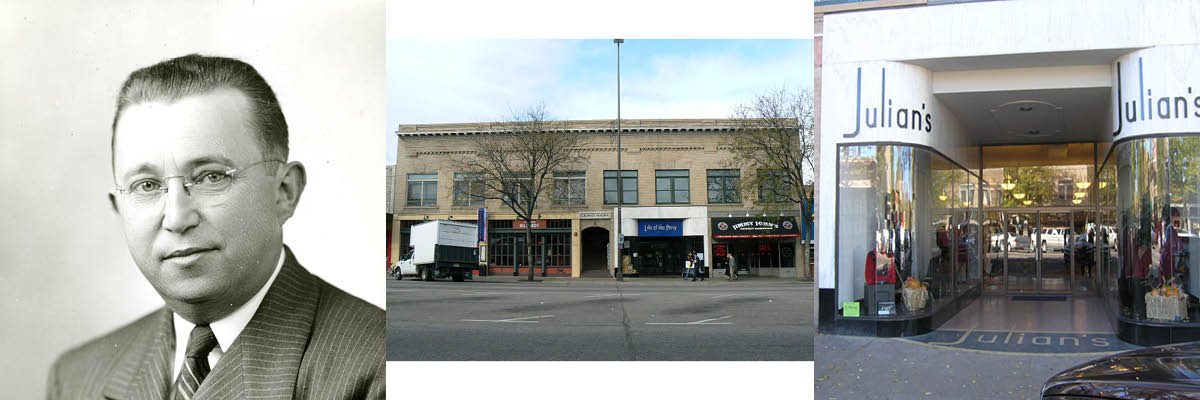
Images: Left: Julian Siegel, 1942, Miller Collection (Fort Collins Museum of Discovery); Center and Right: The Colorado Building 2006 and 2007 (City of Fort Collins HPS).
4 - Julian's, the Colorado Building 133-145 S. College Ave.#
The Colorado building was completed over 1905-1906, commissioned by local investors James C. Douglass and Dr. W.A. Kickland (a local surgeon), designed by local architect Arthur M. Garbutt, and built by M.G. Conley. It was one of several large-scale buildings to be constructed in the so-called “New Town” part of Fort Collins as the city grew and expanded the commercial district south along College Avenue in the 1900s to 1920s. While many shops and restaurants have graced the building over its 120-year life, Julian’s in the 137 S. College unit is of special importance to the city’s Jewish history, being the shop of long-time Fort Collins resident Julian Siegel.
Julian Siegel moved to Fort Collins in 1924, immigrating from Poland, first working as a door-to-door salesman before opening Julian’s, a women’s clothing shop at 114 S. College Avenue. In 1942, he moved his shop across the street to the Colorado Building. Shortly after renting the 137 S. College unit, he commissioned an architect to design a Modern store-front, the one you see today and one of the only of such styled storefronts of its kind to survive in Fort Collins. Julian acquired the northern half of the building in 1957 and continued operating his store here until 1985, and the northern half of the building remains in the Siegel family to this day. Beyond running his shop, Siegel was known in the community as a civil rights advocate from the 1940s to the 1960s. Partnering with Reverend Harold McMillian of the Congregational Church, Siegel and McMillian visited many of the downtown shop owners, petitioning them to remove the “White Trade Only” signs that appeared in many storefronts in downtown Fort Collins through the 1960s. Julian passed away in 1993, and his wife Ida in 2012. They are both buried in Pensacola, Florida.
Other Significant Sites#
Please note that the properties below, while highlighted as important locations, may not be open to the public as they are private residences/sites of worship. Please remain on public sidewalks, respect posted signs, and respect the privacy of the residents/congregation.
502 Wayne Street, the Siegel Residence#
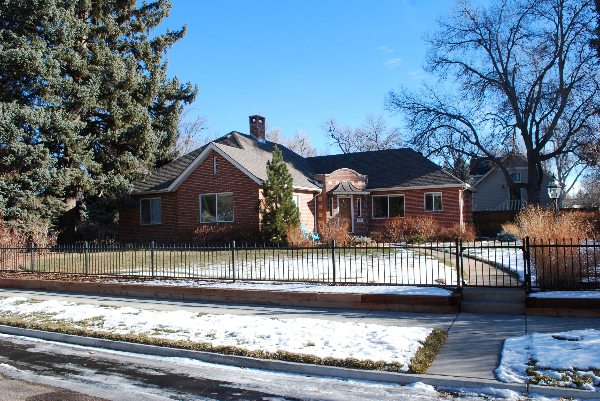
Built in 1941 for the Siegel family, this brick home at 502 Wayne Street remained the Siegel family home for much of their time while living in Fort Collins.
Congregation Har Shalom, 725 W. Drake Rd.#
Congregation Har Shalom became the first permanent synagogue in Fort Collins for the Jewish community co-founded in 1982 by the Aaronson, Hanck, and Sherrod families.